Kramer’s Red Winter Heath has stunning magenta flowers that bloom from January through April. This easy-care evergreen shrub is a must-have for your garden. Plant it for breathtaking Winter and Spring color!
I first learned about heaths and heathers from reading books by the Brontë sisters — especially Wuthering Heights (Emily Brontë) and Jane Eyre (Charlotte Brontë). These classic English novels published in 1847 conjured up mysterious yet magical ideas of what heath and heather looked like on the English moors so vividly described.
Now that I have spent several years growing Kramer’s Red Winter Heath — a hardy and vibrantly colored heath — I marvel at how the Brontës, among other English novelists of the time, described these amazing little shrubs so well.
Video included! Further down in this guide, watch a video I filmed in Springtime, so you can see the shrubs close up and among daffodils!
Kramer’s Rote Heather (Erica x darleyensis ‘Kramer’s Rote’) is beloved for its vibrant magenta blooms in late winter, but this hardy shrub also shines during the summer months. With its neat rounded form and attractive foliage, Kramer’s Rote makes a lovely backdrop for other plants while providing sporadic color. Here’s what to expect from this versatile shrub when summer arrives.
Foliage
The needle-like foliage of Kramer’s Rote remains evergreen through the summer The leaves emerge a fresh green color in spring but deepen to a richer forest green as summer progresses This provides nice contrast of color and texture when combined with plants that have larger, broad leaves.
The dense foliage fills out the plant’s natural rounded shape. Pruning is not required but some gardeners choose to lightly trim Kramer’s Rote in early spring before new growth begins. This helps maintain a compact habit.
Care
Caring for Kramer’s Rote is quite easy during the summer. It thrives in full sun and well-drained acidic soil. Apply an acidic fertilizer formulated for ericaceous plants like azaleas in early spring.
Established plants are fairly drought tolerant. However, Kramer’s Rote appreciates regular water during hot, dry periods in summer. Aim to provide about an inch of water per week from rain or irrigation. Mulching helps retain moisture.
Pests and diseases are not an issue for Kramer’s Rote in summer Deer and rabbits also tend to leave it alone Just watch for occasional aphids on the foliage which can be dislodged by spraying the plant with water,
Blooms
While Kramer’s Rote is prized for its winter blooms it may re-bloom lightly in late summer. Small magenta flower clusters sporadically appear on the branch tips in August and September. Never cut off spent flower spikes after spring blooming as this removes the developing buds for summer.
The summer flowers are less prolific than the vibrant winter blooms. But they provide a nice pop of color among the green foliage. Deadheading spent blooms keeps the plant looking tidy.
Companion Plants
Kramer’s Rote partners well with many perennials that shine in summer. Try combining with asters, coneflowers, daylilies, Russian sage and ornamental grasses. It also mixes nicely with small shrubs like heathers, potentilla and dwarf spirea.
The magenta summer blooms complement pink, purple, yellow and white flowers. For foliage interest, pair Kramer’s Rote with hostas, ferns or variegated plants. It fits nicely along walkways, in rock gardens or mixed borders.
In the Summer Landscape
In summer landscapes, Kramer’s Rote provides nice evergreen structure and backdrop. Its pretty rounded shape and neat foliage also make it well-suited for container plantings on patios and decks. Group several together with vibrant annuals like petunias, marigolds or verbena.
With handsome foliage, sporadic blooms and versatile growing habits, Kramer’s Rote remains a lovely addition to the summer garden. This compact, easy-care shrub earns its place by providing year-round beauty and interest.
Kramer’s Red Winter Heath – Charming Spring Color
Before learning about Kramer’s Rote Heather in summer, it helps to understand this shrub’s origins. Kramer’s Red Winter Heath (Erica x darleyensis ‘Kramer’s Rote’) is a hybrid cross between two heath species – winter heath and Mediterranean heath. It offers the best qualities of both parents.
Kramer’s Red boasts stunning magenta flowers that bloom from January through April. This easy-care evergreen shrub provides breathtaking winter and early spring color.
Many gardeners first discover Kramer’s Red when it’s blooming in nurseries in spring. But it’s actually a winter bloomer that starts flowering in January in warmer zones. The long bloom period bridges the gap between seasons with cheerful color.
Winter Beauty on the Moors
Heather plants have long inspired writers and poets. Author Emily Brontë described the haunting beauty of English moors carpeted in wild heather in her novel Wuthering Heights. The blooming heather she depicted was likely Erica carnea, also called winter heather.
Today’s gardeners can recreate that romantic English heathland beauty by planting hybrid Kramer’s Red. Its low mounding form and vibrant flowers evoke the wind-swept moors. But Kramer’s Red offers improved hardiness and growth for easy care.
Cottage Garden Appeal
With its neat rounded shape and colorful flowers, Kramer’s Red fits perfectly in cottage gardens. Planted near the front of a border, it adds vivid curb appeal and beckons visitors inside.
Kramer’s Red looks charming when underplanted with bulbs like crocus, daffodils or ornamental onions. As the bulbs go dormant, Kramer’s Red continues providing floral color. The magenta flowers also pop against green groundcover plants like lamium, lilyturf or creeping phlox.
Plant Profile
- Exposure: Full sun to partial shade
- Size: 12-18 inches tall x 18-24 inches wide
- Soil: Sandy, well-drained, acidic
- Zones: 5-10
This compact shrub suits any garden needing a burst of winter and spring color. Kramer’s Red is ideal for rock gardens, slopes, borders, groundcover and foundation plantings.
Growing Kramer’s Red Winter Heath
Kramer’s Red Winter Heath thrives when given a sunny, well-drained spot with acidic soil. Amend clay soils with compost or peat moss to improve drainage. Space plants 18-24 inches apart for a dense carpet effect.
These plants need regular irrigation while establishing but become quite drought tolerant once mature. Apply pine needle or bark mulch around the base to help retain soil moisture and acidity.
Prune spent flower spikes after blooming to encourage new growth. Kramer’s Red benefits from an annual application of acidic fertilizer for azaleas and rhododendrons in early spring. With proper siting and minimal care, this hardy heather will flourish for years.
Deservedly Popular
It’s easy to see why Kramer’s Red Winter Heath is popular – it’s beauty, hardiness and cheery flowers appeal to gardeners. As Emma Brontë wrote in Wuthering Heights, heather’s “bloom is even more splendid than that of the wild myrtle.” Kramer’s Rote captures that splendor with flowers that shine from winter through summer.
How to Buy and Plant Kramer’s Red Heather
Gardeners looking to add winter interest and early spring color should consider planting Kramer’s Red Winter Heath. Here’s a quick guide to choosing and planting this popular shrub.
What to Look for When Buying
-
Seek out young plants in 1-2 gallon pots that have healthy green foliage and no dead or yellowing leaves.
-
Look for signs of new growth and flower buds forming if buying in late summer or fall.
-
Choose plants with good branching and a naturally rounded shape.
-
Avoid rootbound or potbound plants with excessive circling roots.
Where to Plant
-
Give Kramer’s Red full sun to partial shade exposure. At least 6 hours of direct sun is ideal.
-
Provide well-drained, acidic, sandy soil. Improve drainage in clay soils before planting.
-
Allow 18-24 inches between plants for a dense, colorful carpet effect.
Planting Tips
-
Dig a hole twice the width and depth of the root ball.
-
Gently loosen any circling roots before placing in hole. Top of root ball should be level with ground.
-
Backfill with native soil mixed with compost or peat moss to improve drainage and acidity.
-
Water thoroughly after planting and as needed until established.
With proper planting and care, Kramer’s Red will thrive for years of beauty and low-maintenance performance. It’s an excellent choice for adding cheery color in late winter when the garden needs it most.
Few shrubs rival the flower power and versatility of Kramer’s Rote Heather. This compact evergreen plant delivers vivid color in late winter when most gardens are still dormant. Its neat mounded form and attractive foliage also lend structure and interest during the summer months. Drought and pest resistant, Kramer’s Rote provides year-round beauty with minimal care required. It partners well with perennials and small shrubs, fitting nicely in beds, borders and rock gardens. Gardeners looking for resilience and season-stretching color should consider incorporating Kramer’s Rote Heather into their landscape.

Kramer’s Red Winter Heath Flowers and Foliage
The flowers are tiny and bell-shaped, completely covering the shrub during their long season of bloom.
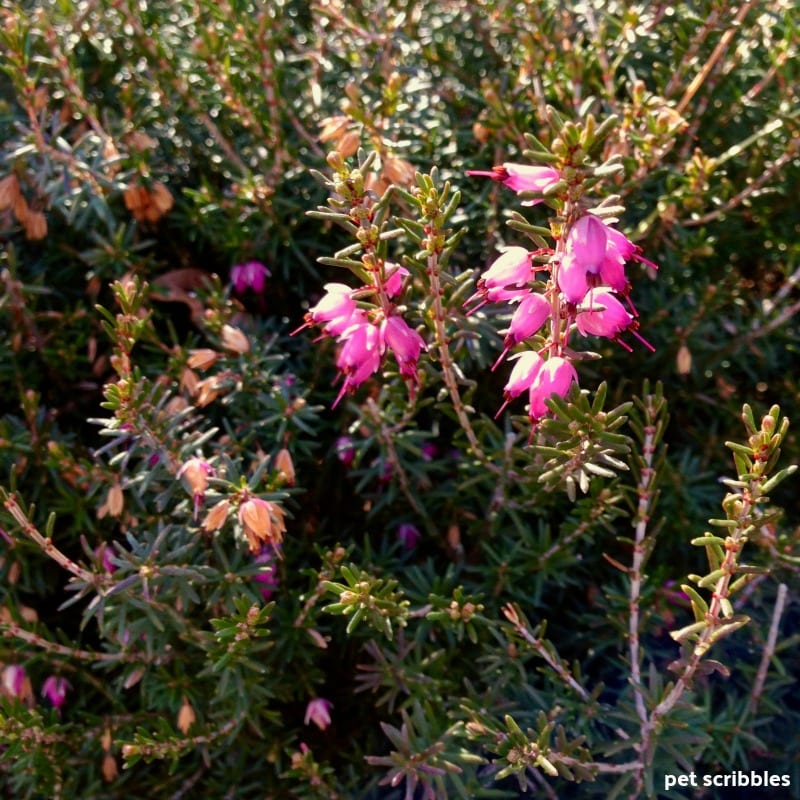
Magenta flowers, yet it is called a red heath or red heather plant. The flower color can look like fuchsia, and sometimes a deeper magenta-red color. Overall, I think magenta is the best way to describe the color.
Early Winter through Mid Spring.
The flowers usually finish blooming by the end of April or beginning of May.
At the end of Kramer’s Red Winter Heath’s long blooming season, its flowers begin to fade so the shrub — up close — looks to have both pink and magenta flowers all over the shrub:
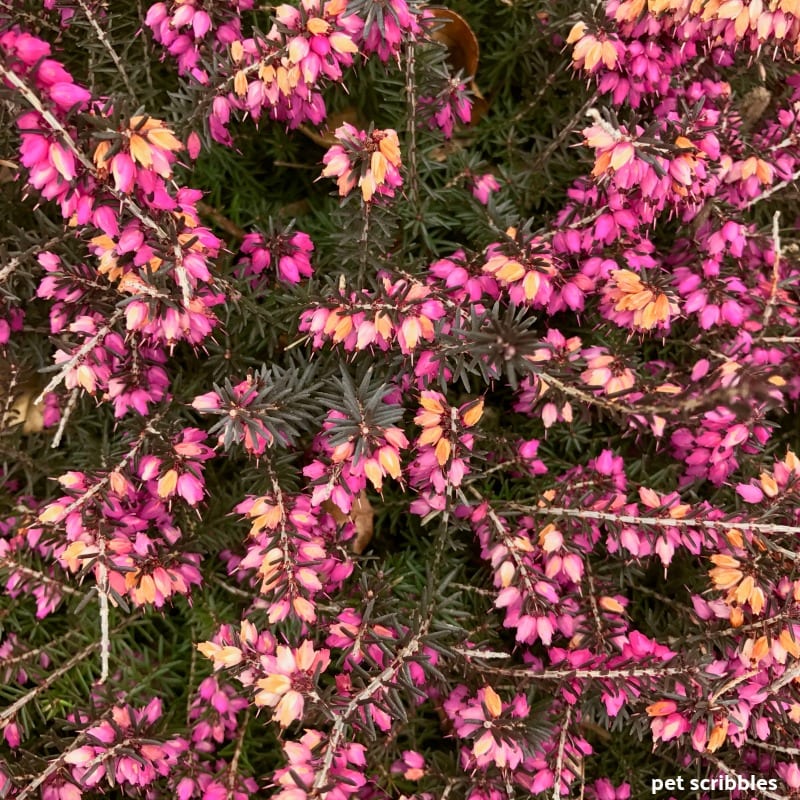
All of the faded blooms will eventually fall off or blow away, as if the plant is self-cleaning!
Here’s the heath with some dried blooms still hanging on among the new green growth in late May:

New growth on Kramer’s Red is bright green, which is followed by the flower buds (also bright green) that form during the Summer.
This shows what the flower buds look like at the end of August:
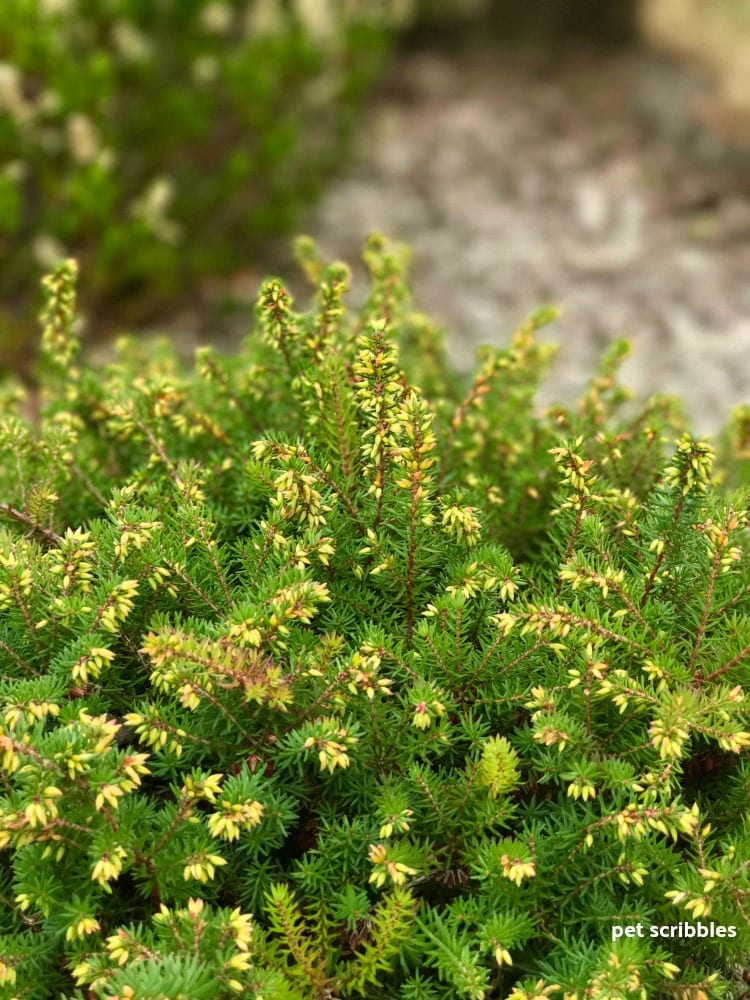
Heath has needle-like green (evergreen) foliage, which can turn to bronze in the Winter and early Spring season, when it’s hidden behind the profuse blooms.
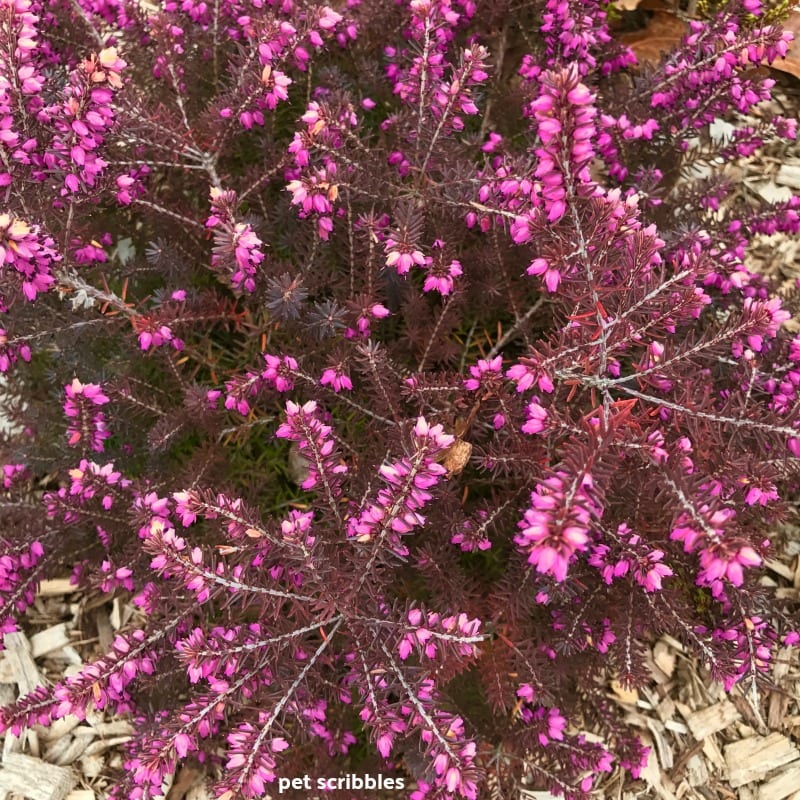
Sometimes late Winter foliage looks almost black to me, but again it just shows off the striking magenta flowers even better. In Summer, the foliage color is a deep green, with brighter green new growth at the tips.
Zones 6 – 8; with some gardeners growing Kramer’s Red Heath in Zone 5.
If you’re unsure, check with your local garden center for hardiness in your particular zone.
I’m in Zone 7, in southern New Jersey near the coast.
Spreads slowly up to 18” high by 24” or more wide.
Best in full sun. Any bit of shade and this particular heather will not flower as well.
Neutral to acid soil, and well draining.
Keep well watered until established. Drought tolerant once established.
However, do watch out during the high heat of Summer that they don’t completely dry out. We keep ours well watered due to the high heat, humidity and blazing sun, especially in July and August.
Kramer’s Red is an acid-loving plant, so I use Holly Tone by Espoma every Spring. It’s a slow-release organic fertilizer perfect for heaths and heathers.
Kramer’s Red Winter Heath in Winter
Kramer’s Red Winter Heath looks brilliant with the vivid flowers surrounded by snow — although the only s I have taken so far show the Winter heath actually covered in snow!
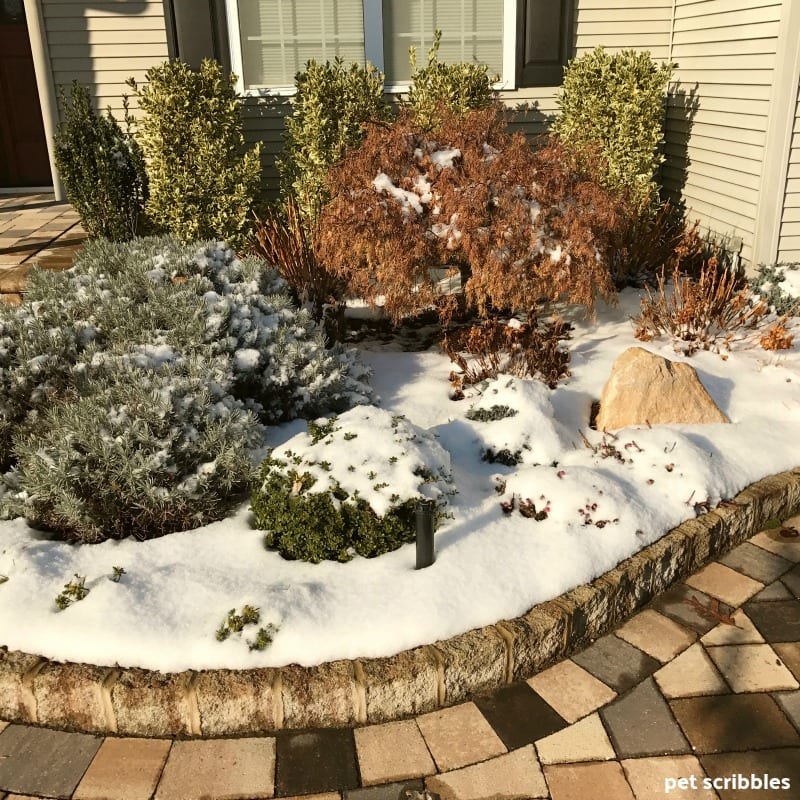
However, the snow does nothing to the gorgeous Winter blooms, and when you’re up close, you can still enjoy the magnificent color.
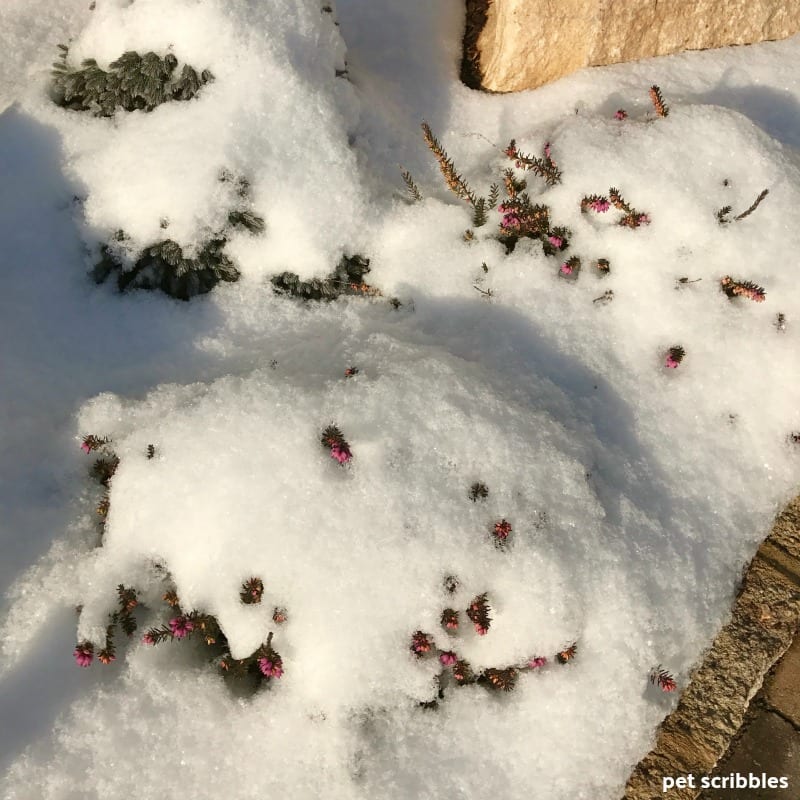
Snow doesn’t smash the plant or damage the blooms — it’s quite a tough little shrub!
Kramer’s Red Heather
FAQ
How do you care for Kramer’s rote heather?
Performs best in full sun in sandy, acidic, medium moisture, well-drained soils. Part shade is welcomed in hot summer areas. Newly planted Heath can dry out quickly once planted, so it is important to water regularly and thoroughly when the plant is young.
What happens to heather in summer?
Calluna heathers flower in summer and autumn. These acid-loving species need a light, sandy but nutrient-rich soil, with a pH of 6.5 or less. Erica heathers typically flower in winter and spring (there are some summer-flowering species).
Is Kramer’s Red heather a perennial or annual?
Kramer’s Red Spring Heather is a colorful powerhouse. This sun-loving perennial has needle-like dark green foliage with a slight bronzy tone. Deep purplish-red flowers grow on upright branches evenly spaced between the foliage. During the spring, the entire shrub will be engulfed in blooms.
What is Kramer’s Rote Heather?
Kramer’s Rote Heather (Erica x darleyensis ‘Kramer’s Rote’) is a beautiful evergreen shrub that provides year-round interest in the garden. While most known for its vibrant magenta-red winter blooms Kramer’s Rote also shines during the summer months. Its neat rounded form and attractive foliage make it a lovely backdrop for other plants.
Is Kramer’s rote a shrub?
Loved for its outstanding upright, bushy habit, evergreen foliage, and glimmering flowers, award-winning Erica x darleyensis ‘Kramer’s Rote’ or ‘Kramer’s Red’ (Winter Heath) is a compact, vigorous shrub with clouds of magenta flowers from mid-winter to mid-spring (Jan-Apr), covering the dark bronze-green foliage.
Does Kramer’s Rote bloom in summer?
While most known for its vibrant magenta-red winter blooms Kramer’s Rote also shines during the summer months. Its neat rounded form and attractive foliage make it a lovely backdrop for other plants. Here’s what to expect from this versatile shrub when summer arrives. Foliage
When does Kramer’s red winter heath Bloom?
Kramer’s Red Winter Heath has stunning magenta flowers that bloom from January through April. This easy-care evergreen shrub is a must-have for your garden. Plant it for breathtaking Winter and Spring color!.
Can Kramer’s Rote winter Heathers grow in shade?
While the product description suggests planting in shade, the key product features also list “Full Sun” as a sun tolerance. This likely means it can tolerate a range of light conditions, from full sun to shade. Customers say the Kramer’s Rote Winter Heathers arrive well-packaged and in excellent condition, often blooming beautifully upon delivery.
How do you grow Kramer’s Rote Heather?
The shrub is slow growing a rarely grows above one ft., making it ideal for planting in rock landscapes. We suggest that your new Kramer’s Rote Heather is planted in shade and fertile, acidic, well-drained soil for the best growing results. Erica x d. ‘Kramer’s Rote’ How can we improve our product information? Provide feedback.
